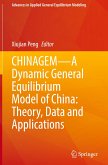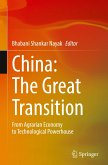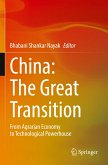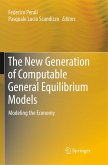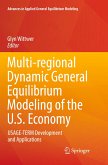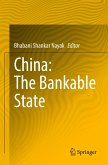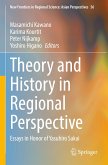CHINAGEM-A Dynamic General Equilibrium Model of China: Theory, Data and Applications
Herausgegeben:Peng, Xiujian
CHINAGEM-A Dynamic General Equilibrium Model of China: Theory, Data and Applications
Herausgegeben:Peng, Xiujian
- Broschiertes Buch
- Merkliste
- Auf die Merkliste
- Bewerten Bewerten
- Teilen
- Produkt teilen
- Produkterinnerung
- Produkterinnerung
This book contains detailed documentation of the CHINAGEM model - a large-scale dynamic computable general equilibrium (CGE) model of China and its applications. Specifically, this book documents the theory and database behind the CHINAGEM model. This book explores the closure development for the four simulation modes of the model including historical, decomposition, forecast and policy simulations, the detailed explanation of how to analyze simulation results, and the extensions of CHINAGEM and their applications. These extensions include several innovative modules and case studies as…mehr
Andere Kunden interessierten sich auch für
![CHINAGEM-A Dynamic General Equilibrium Model of China: Theory, Data and Applications CHINAGEM-A Dynamic General Equilibrium Model of China: Theory, Data and Applications]() CHINAGEM-A Dynamic General Equilibrium Model of China: Theory, Data and Applications127,99 €
CHINAGEM-A Dynamic General Equilibrium Model of China: Theory, Data and Applications127,99 €![China: The Great Transition China: The Great Transition]() China: The Great Transition127,99 €
China: The Great Transition127,99 €![China: The Great Transition China: The Great Transition]() China: The Great Transition127,99 €
China: The Great Transition127,99 €![The New Generation of Computable General Equilibrium Models The New Generation of Computable General Equilibrium Models]() The New Generation of Computable General Equilibrium Models134,99 €
The New Generation of Computable General Equilibrium Models134,99 €![Multi-regional Dynamic General Equilibrium Modeling of the U.S. Economy Multi-regional Dynamic General Equilibrium Modeling of the U.S. Economy]() Multi-regional Dynamic General Equilibrium Modeling of the U.S. Economy97,99 €
Multi-regional Dynamic General Equilibrium Modeling of the U.S. Economy97,99 €![China: The Bankable State China: The Bankable State]() China: The Bankable State112,99 €
China: The Bankable State112,99 €![Theory and History in Regional Perspective Theory and History in Regional Perspective]() Theory and History in Regional Perspective119,99 €
Theory and History in Regional Perspective119,99 €-
-
-
This book contains detailed documentation of the CHINAGEM model - a large-scale dynamic computable general equilibrium (CGE) model of China and its applications. Specifically, this book documents the theory and database behind the CHINAGEM model. This book explores the closure development for the four simulation modes of the model including historical, decomposition, forecast and policy simulations, the detailed explanation of how to analyze simulation results, and the extensions of CHINAGEM and their applications. These extensions include several innovative modules and case studies as examples of the application of CHINAGEM.
This book provides an entry point for CGE modellers to develop their analytical skills. This book can also be used as a platform for research institutes to develop CGE models suitable for their research portfolio. The module developments included in this book are designed to capture the specific features of the Chinese economy. The applications of these modules chosen in the book cover hot policy issues in China, and the simulation results have valuable policy implications. This book identifies that the CHINAGEM model itself and all the extensions can be used for analysing many new topics and policy issues such as the effects of the USA-China trade war, the effects of Made in China 2025 Plan as well as China's commitment to the carbon neutrality before 2060 and its economic implications.
This book provides an entry point for CGE modellers to develop their analytical skills. This book can also be used as a platform for research institutes to develop CGE models suitable for their research portfolio. The module developments included in this book are designed to capture the specific features of the Chinese economy. The applications of these modules chosen in the book cover hot policy issues in China, and the simulation results have valuable policy implications. This book identifies that the CHINAGEM model itself and all the extensions can be used for analysing many new topics and policy issues such as the effects of the USA-China trade war, the effects of Made in China 2025 Plan as well as China's commitment to the carbon neutrality before 2060 and its economic implications.
Produktdetails
- Produktdetails
- Advances in Applied General Equilibrium Modeling
- Verlag: Springer / Springer Nature Singapore / Springer, Berlin
- Artikelnr. des Verlages: 978-981-99-1852-2
- 2023
- Seitenzahl: 300
- Erscheinungstermin: 11. September 2024
- Englisch
- Abmessung: 235mm x 155mm x 17mm
- Gewicht: 458g
- ISBN-13: 9789819918522
- ISBN-10: 9819918529
- Artikelnr.: 71539952
- Herstellerkennzeichnung Die Herstellerinformationen sind derzeit nicht verfügbar.
- Advances in Applied General Equilibrium Modeling
- Verlag: Springer / Springer Nature Singapore / Springer, Berlin
- Artikelnr. des Verlages: 978-981-99-1852-2
- 2023
- Seitenzahl: 300
- Erscheinungstermin: 11. September 2024
- Englisch
- Abmessung: 235mm x 155mm x 17mm
- Gewicht: 458g
- ISBN-13: 9789819918522
- ISBN-10: 9819918529
- Artikelnr.: 71539952
- Herstellerkennzeichnung Die Herstellerinformationen sind derzeit nicht verfügbar.
Dr. Xiujian Peng is a senior research fellow at the Centre of Policy Studies (CoPS), Victoria University, Australia. Previous appointments include a senior research associate at the University of Adelaide and a senior lecturer at the Institute of Population Research, Renmin University of China. In her doctoral research at Monash University, she applied CGE modelling to simulate the macroeconomic consequences of population ageing and related policy choices in China. The thesis was awarded the prestigious Mollie Holman Doctoral Medal in 2005. Dr. Peng has published widely in international peer-reviewed journals. Dr. Peng's main area of expertise centres on the development of general equilibrium models and their application to China, with particular emphasis on demography, labour markets, energy and economic growth. She has led and completed many research projects covering various economic issues in China. Her recent research on China's population issues has attracted a lot of attention worldwide. As a principal investigator, she has provided consulting services to governments, research institutions, and universities in many countries including the United States, China, Australia, South Korea and Thailand. Authors Peter Dixon was awarded his PhD by Harvard in 1972. After working at the IMF, Dixon joined the IMPACT Project in 1975. He was the joint recipient of the 1983 Research Medal of the Royal Society of Victoria for IMPACT's contribution to social sciences in Australia. He was elected Fellow of the Academy of Social Sciences in Australia in 1982; awarded the Distinguished Fellowship of the Economic Society of Australia in 2003; appointed Sir John Monash Distinguished Professor by Monash University in 2006; elected to the Hall of Fame in the Global Trade Analysis Project in 2015; and awarded an honorary doctorate by the University of Pretoria in 2021. In 2014, he was appointed Officer in the Order of Australia. Dixon is known internationally for his work in computable general equilibrium modelling. Together with colleagues, he created the ORANI model and its dynamic successor, MONASH. These models have been prominent in the Australian economic debate for 45 years and are used world-wide as modelling templates. In recent years, he has led the development of the USAGE model of the U.S. which is used in government agencies in Washington DC. Dixon's publication list contains 245 articles and 10 books. Philip Adams is a Professor at Victoria University's Centre of Policy Studies. He was elected a Fellow of the Academy of the Social Sciences in Australia in 2016. In that year, he was also awarded the GTAP Research Fellow distinction for the term of 2016 to 2019. He holds a master's degree and a Ph.D., both in economics, from the University of Melbourne. His current research interests are the economics of climate change and climate-related policies, economic policy modelling in developing countries, and the economic impacts of major health events such as COVID-19. Over recent years he has completed a number of projects for Australian federal and state governments, assisting them in model development and model applications to issues associated with climate change, adaptation, and abatement through emissions trading. He has also led overseas modelling projects in Uganda, Jordan, Oman, Saudi Arabia and South Africa. In recent years, he has been involved in several projects examining the economic impacts of COVID-19 on Australia, with specific reference to the state economies. He is author or co-author of over 70 peer-reviewed academic publications, including articles in Nature and Vaccine. Dr. Yinhua Mai was an associate professor at the Centre of Policy Studies between 2005 and 2013 at Monash University. She has over twenty years' experience in economic research and consulting. She holds a Ph.D. in Economics of Development from the Australian National University. Dr. Mai is a Ph.D. supervisor and an experienced lecturer, especially in teaching dynamic computable general equilibrium (CGE) modelling. Dr. Mai has conducted CGE modelling analysis for many clients such as the Australian Department of Foreign Affairs and Trade, the Asian Development Bank, the Australian Greenhouse Office, Wool Innovation and ITS Global. She is experienced in running CGE training and capacity-building projects. Since 2005, she has helped a number of research institutes in China and Malaysia to develop CGE policy-analysis capacities. Dr. Mai has published widely in the areas of international trade, energy and labour market analysis, especially in relation to economic development issues in China. Yinhua Mai is currently a clinical doctor in Melbourne, Victoria. Maureen Rimmer has been a Professor in the Centre of Policy Studies at Victoria University since 2014. Her earlier appointments include a professorship at Monash University and teaching/research positions in economics and mathematics at Melbourne, Monash and La Trobe universities and at the IMPACT Project. Rimmer has a Ph.D. in mathematics (LaTrobe) and a Masters in economics (Melbourne). She is the author and co-author of about 80 published articles in economics and mathematics. She has also authored/co-authored several hundred reports for CoPS' clients mainly from the government sectors of Australia and the U.S. She is a co-developer of the MONASH model of the Australian economy and co-author of the MONASH book. In the last twenty years, she has been a key contributor in the development, application and documentation of USAGE, a 500-industry, dynamic model of the U.S. economy. In 2015, the Global Trade Analysis Project recognized Maureen's international standing through the award of a Research Fellowship with the following citation: "For being instrumental in developing two of the most prominent country-level CGE models in the world --MONASH and USAGE, both of which contain innumerable innovations including model validation, econometric estimation, macro-economic forecasting, and highly disaggregated and regional analysis. ..." Xuejin Zuo is a professor and former director of the Institute of Economics, Shanghai Academy of Social Sciences, Shanghai, China. He was also the former president of the Shanghai Academy of Social Sciences. His major research fields are China's population economics, social security program reform and urban and regional development studies. He has a wide range of publications in Chinese and English-refereed journals. He has led and completed several national key research projects and was awarded many prizes. Professor Zuo holds a Ph.D. in economics from the University of Pittsburgh in 1989. He spent a postdoctoral year at the Princeton University and another yearat the US Bureau of the Census as a visiting fellow. Dr. Xin Yang is a professor in the Institution of Information Sciences at the Shanghai Academy of Social Sciences (SASS). As a director of the Yangtze River Economic Zone research, she focused on aging, migration, social integration of migrants and social security, especially on healthy aging in China, the impact of aging on China's social and economic development, and migrant workers' social security. She has undertaken several state and municipal-level projects in population and socio-economic development. Dr. Meifeng Wang is an assistant researcher at the Shanghai Health and Health Development Research Center (Shanghai Institute of Medical Science and Technology Information). In her doctoral research at the Shanghai Academy of Social Sciences, she mainly devoted herself to the research of population forecast, demographic economics and the CGE models. In the field of population aging research, she presided over a Shanghai philosophy and social science planning project and participated in a number of national philosophy and social science projects and the National Natural Science Foundation projects, She has published a number of articles in refereed Chinese journals. Dr Jingliang (Charles) Xiao is a Senior Advisor at the office of the Chief Economist in Global Affairs Canada (GAC). He has extensive experience in Economic modelling. Before he joined GAC, Charles co-found a consulting company, Infinite-Sum Modeling (ISM) Inc. He also worked as a Senior Research Associate at Ciuriak Consulting Inc. Charles holds a Ph.D. in Economics from the Centre of Policy Studies (CoPS), Monash University, Australia. His doctoral thesis was developed under the tutelage of Professor Peter Dixon, a leading expert in the field. Charles has highly developed research skills with a particular focus on economic modelling, having practical experience in both building and teaching Economic models. Charles published over 30 academic papers and two books. His research has appeared in academic journals and has been cited by publications including the Economist, 'The Globe and Mail', National Post, and the Wall Street Journal. His clients include a broad array of international agencies, governments, and private sector organizations. Dr. Shenghao FENG is an economist at KPMG Australia. He holds a PhD in Economics from the Australian National University. Shenghao specializes in answering what-if questions using computable general equilibrium models. His primary research interests include energy, climate, environment, infrastructure, trade, and global value chains. He is a co-developer of the CHINAGEM-E model. Prior to KPMG, he worked as an analyst at the University of International Business and Economics, the Chinese Academy of Sciences, and China Policy. Shenghao has published in Energy Economics, Applied Energy, and has led or participated in consulting works on low-carbon development, trade issues, and infrastructure projects. Professor James Giesecke is the Director of the Centre of Policy Studies at Victoria University. Prior to his current position he was Professor and Deputy Director of Centre of Policy Studies at Monash University (2012-14). His research is in the development of large-scale multi-regional and national computable general equilibrium (CGE) models, and the application of these models to the analysis of the determinants of economic growth and structural change, forecasting, and policy analysis. He has published over sixty papers in peer-reviewed journals and edited books on these topics, and has over twenty-five years of experience applying economic models to diverse domestic and international public policy questions through research contract engagements with government. Glyn Wittwer is a Professor with the Centre of Policy Studies (CoPS) at Victoria University. He has played a major role in collaborative efforts to develop databases for multi-regional CGE models in several countries. He has developed dynamic versions of these models for Australia, Canada, China, New Zealand and the US. More recent models devised by Wittwer include dynamic multi-country models with sub-national detail, EuroTERM and GlobeTERM. Wittwer has edited and contributed the majority of chapters in the Springer volumes Economic Modeling of Water (2012) and Multi-regional Dynamic General Equilibrium Modeling of the US Economy (2017). The first volume included some of the most detailed depiction of water allocation possibilities in a multi-regional CGE model. Professor Wittwer has published on key water allocation issues in Australia including the 2007 Water Act and prospective irrigation schemes in remote regions. The second volume documented some of the ground-breaking model development undertaken by colleagues Professors Peter Dixon and Maureen Rimmer on the US economy, extending their work to a regional dimension. Wittwer has also edited a Springer volume Economy-Wide Modeling of Water at Regional and Global Scales.
Part 1: Introduction: CGE and its contribution to the policy debate.- Chapter 1.Introduction/Overview.- Chapter 2.Contribution of CGE modelling in international and national policy debate.- Part 2: Equations and data, and closures for historical, decomposition, baseline and policy simulations.- Chapter 3.Equations and solution method of CHINAGEM model.- Chapter 4.Database Chatper 5.Closures of CHINAGEM model.- Chapter 6.Illustration of closures: the Chinese economy from 2012-2030.- Part 3: Applications and add-on modules.- Chapter 7.Labour market reform and economic growth - Labour market module and its application.- Chapter 8.Population ageing, pension system reform and economic growth -pension module and its application.- Chatper 9.China's new population policy and its effects on macro economy - population projection module and its application.- Chapter 10.China's economic transition and its effect on energy demand and greenhouse emissions - energy and climate change module and its application.- Chapter 11.Regional extension.
Part 1: Introduction: CGE and its contribution to the policy debate.- Chapter 1.Introduction/Overview.- Chapter 2.Contribution of CGE modelling in international and national policy debate.- Part 2: Equations and data, and closures for historical, decomposition, baseline and policy simulations.- Chapter 3.Equations and solution method of CHINAGEM model.- Chapter 4.Database Chatper 5.Closures of CHINAGEM model.- Chapter 6.Illustration of closures: the Chinese economy from 2012-2030.- Part 3: Applications and add-on modules.- Chapter 7.Labour market reform and economic growth - Labour market module and its application.- Chapter 8.Population ageing, pension system reform and economic growth -pension module and its application.- Chatper 9.China's new population policy and its effects on macro economy - population projection module and its application.- Chapter 10.China's economic transition and its effect on energy demand and greenhouse emissions - energy and climate change module and its application.- Chapter 11.Regional extension.


